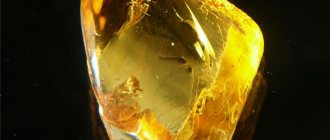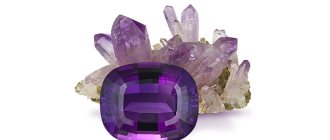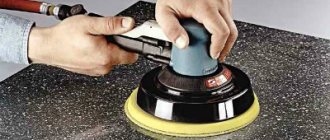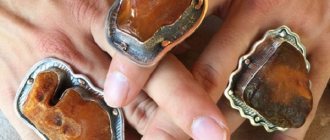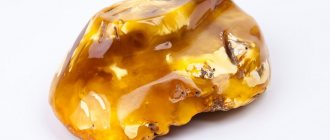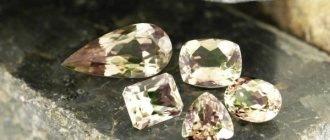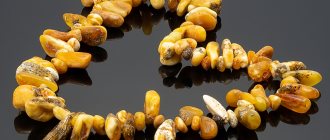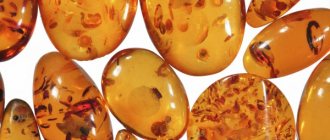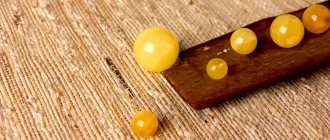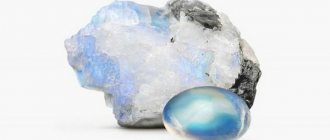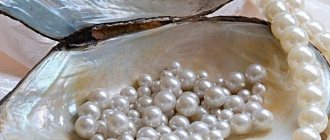This valuable stone has a huge number of colors and shades. The most common color is honey, or sunny. This is usually the color of the Baltic species of this fossil. However, there are a huge variety of shades of the mineral. Most often these are all shades of yellow, from the palest to dark brown and even black. There are also rarer tones. For example, cherry and green amber are extremely rare, but blue amber is the rarest - only 0.2% of the total production. A very beautiful stone is mined in Sicily; it has a bright, fiery hue. Color can vary greatly depending on the type of wood and inclusions of air bubbles. Certain minerals present nearby can also give the fossil resin different shades.
Types of Baltic amber
The most common type of amber is succinite. It is the most popular color - yellow. The stone's name comes from Pinus succinieferra, a prehistoric pine tree that once grew along the Baltic Sea coast.
Gedanite is related to succinite in its origin; both species are derived from the resin of the same tree species. The only difference is the composition of the resin and the conditions under which it hardened. While succinite was fossilized and exposed to oxygen, gedanite hardened due to weathering. Succinic acid is practically not contained in gedanite, and its color is not yellow or honey, but earthy and dark.
Gedanite is sometimes called “rotten amber”; its extraction accounts for only 2% of the total volume. It is interesting that the name of this type of mineral was given by the city, which is now called Gdansk, where gedanite deposits are concentrated.
Stanthienite is the same famous black amber , so popular in the 19th century as a mourning decoration. This is one of the rarest varieties of this fossil. Black amber is very difficult to process due to its fragility, and modern mining methods only destroy it. Black amber does not withstand the pressure of powerful jets of water, which are used to erode the earth when extracting the stone.
Glessite is a featureless form of succinite. It is soft, has a dirty color and is not used either in jewelry or in interior decoration.
Other types of amber
Blue amber is the rarest and hardest type of this mineral. This incredibly beautiful stone is found only in the Dominican Republic, Mexico and Nicaragua, everything else is fake. It is very difficult to process, so the cost of the processed mineral is very high. The depth of color depends on the lighting - in the dark the stone takes on a deep blue color. Due to the admixture of volcanic ash, the stone becomes phosphorescent in the dark. It’s interesting that when held up to light, blue amber appears yellow.
After blue, green amber is the second rarest on the planet. It is found naturally only in the Dominican Republic. The history of its mining began back in the time of Columbus, when green amber was discovered on the island of La Hispaniola. This stone is mined in very deep mines, still using the simplest tools. Green amber is often found in the brown coal from which it is mined. The cheapest stone is mined in the Sabana and Bayaguana mines; it is quite soft and requires additional processing. The best green amber is mined only in the La Cordillera mine.
Red amber is called “dragon’s blood” for its cherry hue. No one knows exactly how it acquired this color, but it is assumed that most likely, the resin of the tree was originally cherry in color. Paler pink amber is also often found. Red stones, as a rule, are found not one at a time, but in entire deposits. The fiery mineral is mined in Ukraine near Lvov, as well as in Sicily, Japan, Burma and Australia.
How to identify real amber - what is used for fakes
Amber is one of the most popular jewelry stones, known to man since ancient times. In addition to honey color, white (royal), green, blue and landscape amber are also found in nature. The stone receives all these shades during the growth process, depending on the soil where it is formed and the accompanying elements. Uncharacteristic colors for amber: red, green and white increase the cost of the stone tens of times, hence the high demand for the stone, and accordingly the field of activity for scammers.
Natural amber is often replaced with other materials. It is important to familiarize yourself with some of their properties in order to know how to distinguish a fake.
Pressed amber
Pressed amber is practically not inferior in quality to natural stones. Its transparency is relatively low, with many small air bubbles. Its color is uneven. It is made from small amber or amber waste.
It is difficult to distinguish the imitation from real stones even for an experienced jeweler, since the base is made of natural amber chips. But there are still a few differences.
- Melts easier.
- When heated, it emits an unpleasant medicinal odor.
Resin
Since amber itself is a fossilized resin, attempts are often made to imitate it using a similar material, fossilized resin.
Beautiful imitation natural stone made of resin
Often the fake has a distinct pine smell. This scent is lost in amber, but can emerge when exposed to extreme temperatures. Resin fakes have a uniform structure, with few flaws, and sometimes no defects at all. Amber has been grown for centuries and therefore has color transitions, inclusions, etc.
dug
Copal is similar in properties to amber. It is also conifer resin, but samples are only 100,000 years old. Amber was formed over several million years.
However, it is almost impossible to distinguish fakes: often even experienced jewelers cannot find the differences upon inspection. To identify a fake, samples are melted. This option is used as a last resort because it damages the stone.
Cowrie
Kauri is a type of tree from which resin is extracted to make artificial jewelry. After high-quality processing, the stone looks like the original, but lacks its hardness.
Cowrie is even more easily damaged than amber, which is why it is rarely used for jewelry. Most often, resin is used to make furniture and accessories.
Faturan
Faturan is a special mixture invented in the early 18th century by artisan Ismail Almail. He decided to mix amber waste with natural resins. The result is a stone that closely resembles the original, but does not have all its properties. Its main characteristic is hardness.
Faturan has characteristic swirls. The most valuable samples contain flakes of gold, which give the mineral the appearance of molten lava. Faturan was considered a precious stone. Even his contemporaries dreamed of buying it. The mineral had a dull surface and a bright reddish-honey color.
Faturan stone with gold
Later, the recipe for the mixture was lost, so faturan also began to be counterfeited. The Hamburg company Traun & Son tried to copy it on a production scale. The basis of artificial faturan is bakelite. Such imitations were created until the 1940s. They also have their value, but the minerals created by Ishmael are more expensive. Sometimes their price exceeds the price of amber.
Plastic
Plastic imitations of amber first appeared in the 18th century, and became most widespread during the First World War.
This period coincided with rising prices for natural resources, deepening stratification of society and a decline in the standard of living of mankind. As a result, people were forced to invent inexpensive imitations.
Plastic counterfeits are easy to distinguish by their uniform structure, unnaturally light color and uniform coloring. The material is lightweight and weighs less than the original.
Glass
Amber began to be counterfeited with glass as soon as metallurgists learned to give this material any desired shape. With the help of additives, they began to obtain honey shades.
However, despite the efforts of craftsmen, glass is still easily distinguishable by its physical characteristics. It heats up slowly and cools quickly, making it colder than amber. The glass is relatively heavy, the luster is even more pronounced, the internal sculpture is completely different from that of amber and melts at a higher temperature.
Bernit
Bernite is a man-made mixture of polyester resins. Bernite contains amber, but not more than 5%, and is produced from low-quality varieties. Most often this is industrial waste.
In addition, the mineral is subjected to internal processing to replicate internal chips and fan formations. Bernite can be recognized by its appearance: its stones are flat and of the same size, larger, but cheaper than amber.
Magic properties
The magical properties of amber are as varied as their healing ones. Since ancient times, the “Gift of the Sun” has been used as a powerful talisman that protects against the evil eye. It is considered a symbol of health, happiness and longevity. The raw pieces were placed on the pillow to drive away evil spirits.
The mineral has also found great use in religious rites. It burns well and emits a pleasant aroma. For pregnant women, he is a real protector and guarantees a healthy fetus and successful childbirth. “The Gift of the Sun” fills the house with luck and protects it from fires. It gives good luck and good spirits to its owner.
How to distinguish amber from plastic
To determine the naturalness of stones, it is necessary to take into account their variety. Moreover, each crystal has certain characteristics; as for plastic, craftsmen have learned to use all types of this material to make highly professional fakes. Such stones are suitable as jewelry; they are really beautiful and almost “eternal.” The main differences from real stone:
- lighter in weight;
- uniform color or with a characteristic curl that is formed when paint is spread;
- smooth surface.
Among plastic counterfeits, the most common are the following.
Acrylic
Real, unprocessed amber from the mines of Volyn
Acrylic is a popular material for fakes. Unscrupulous sellers advertise them through websites. Such stones are distinguished by their rich shade and perfectly smooth surface.
Bakelite
This stone is also called African amber. However, it is made of plastic. Unlike natural stones, gemstone reacts to solvents.
Celluloid
In the 19th century it was used as an inexpensive alternative to ivory. It is distinguished by a light shade and pronounced unevenness in texture.
Place of Birth
Russia is considered the main supplier of amber on the world market. About 90% of the stone is mined in the Kaliningrad region alone. Less significant deposits are concentrated in Siberia, the Urals and Sakhalin.
Lithuania is famous for its high quality amber samples. In Ukraine, the mineral is mined in the Volyn, Kyiv, Zhytomyr and Rivne regions.
Other most famous deposits of sunstone are located in Indonesia, the Dominican Republic, Mexico, Myanmar, North America, Italy and Romania.
How to distinguish amber from a fake at home - verification methods
There are several reliable ways to distinguish natural amber from fakes. In each of them, the unique physical and chemical properties of the original stone play an important role. Substitutes either do not have these characteristics or have them in much smaller quantities.
For example, real stones are characterized by low thermal conductivity. Upon tactile contact, amber is warm, glass is not. The hardness of artificial stone is also higher than that of natural stone. You can even feel it with your fingers. Copal and cowrie, on the contrary, have a softer structure.
Visual inspection
It is important to carry out a visual inspection. The unusual structure of natural stone is its “calling card”. Microcracks, inclusions, and heterogeneous structure indicate its natural origin. Glass products, on the other hand, are characterized by transparency and play of light. Plastic objects exhibit similar properties at lower intensities.
Inclusions
Previously, the main distinguishing feature of authenticity was the presence of insects or other fragments. Currently, technological progress has made it possible to place any elements inside the work. It is extremely difficult to assess their ancient origins. You should also pay attention to the air bubbles inside. Their spherical shape defines the stone as natural. Elongated bubbles indicate less dense material, which is clearly a fake.
Aroma
Let's look at the features of the smell. The smell of the original stone intensifies when heated, for example by rubbing. You can also apply a hot needle to a less visible area. This manipulation will reveal the aroma of rosin (a mixture of pine needles and cloves).
Electrostatic charge
One of the main properties of amber is its ability to attract lint and small pieces of paper when rubbed intensively. Nowadays, plastic can also become electrostatic, but not to the same extent. Other types of resins do not have these properties.
Ultraviolet testing
The action of an ultraviolet lamp will help us distinguish natural amber from fakes. The transparent stone glows blue with varying intensities. Darker, smoky samples glow pale blue when exposed to ultraviolet light. The bone variety glows milky white with a slight bluish tint.
It is important to use all of the above testing methods together. In this case, there is a high probability of obtaining an accurate result.
Characteristics of the mineral
The noble brother of the familiar cognac or honey amber is never translucent or transparent. It has a dense white or bone color with blue, yellow, black and blue inclusions. The rare stone occupies the first position in the classification of fossil resins and is classified as jewelry.
Royal amber, a photo of which is quite rarely seen even on the pages of special publications, only visually appears to be so. In fact, it is yellow, but during formation it is filled with microscopic particles of moisture and air. The shade of the mineral depends on the percentage of these components. The more air and moisture it contains, the lighter the stone and the more matte its structure.
This natural mineral of stunning beauty is extremely popular among jewelers all over the world and has the fame of a magical amulet. In our opinion, the magical properties of the stone depend rather on self-hypnosis, but the healing properties are truly inherent in white amber.
Distinctive features of amber
This gem is soft - up to 2.5 units on the Mohs scale. It is easily scratched by glass or a knife, and has a low density, so it is lightweight. The stone burns and melts at a temperature of about 200 degrees Celsius, releasing the characteristic smell of pine and cloves. Depending on the degree of transparency of the stone, varieties are distinguished - transparent, translucent, opaque (the so-called bone). The latter is not valued in its pure form, so it is processed and melted to obtain “reconstituted” amber, which will be transparent.
Bubbles in amber
Some consultants argue that too many air bubbles and inclusions indicate imitation amber.
However, natural amber in the form of a puddle contains many air bubbles. In imitations made from copal, glass, or epoxy resin, there may be very few of these bubbles.
How to distinguish natural amber from fake by inclusions
Insects or plant particles trapped in the hardened resin are called inclusions. Their presence indicates that it is a natural stone. However, such inclusions can be artificially introduced into the resins of other trees.
It is difficult to discern the nature of the inclusions, but they can be examined carefully
If the insect is frozen, evenly spreads its legs or wings and is not in motion, this is a sign of copal or resin.
Inside the resin, the insect hardens and is located in one port. If on the presented sample it has noticeably dried out and died off long ago, then it is an imitation.
Leaves, grains of sand, sticks - all of this falls chaotically inside. Carefully placed contents inside a gemstone are a sign of a fake.
Cost of jewelry
In terms of value in jewelry, red amber gem is second only to blue Dominican.
The Russian market offers to buy mainly accessories with Baltic stone (cost, thousand rubles):
- gold pendant with a solid stone (3x4 cm) – 18.5;
- silver earrings – 0.8-2.5;
- gold ring – 12.5–16.7;
- gold earrings – 15–20;
- women's bracelet (9–17 mm) – 3.6–8.8.
The price depends on the size of the amber fragments and the amount of valuable metal.
Earrings with red amber
Testing the authenticity of amber with salt water
The easiest way to distinguish amber from a fake is to test it in salt water. Prepare a solution of 10 tablespoons of salt in 0.5 liters of water, and then dip the object into it. Natural mineral, unlike glass or epoxy imitations, does not sink.
Ultraviolet
Natural amber glows blue and green under ultraviolet light, but artificial resins, plastic and glass do not. Copal and casein-based artificial amber glow yellow. What to do if you don't have a UV lamp at home? You can’t buy it just for diagnostics, can you? There is a little trick: you can ask for your amber to be illuminated with an ultraviolet lamp in a beauty salon or with a banknote scanner at the cash register.
Weight
Plastic is lighter than amber. Glass is heavier. The exception is foamy varieties of amber, which have numerous pores that give it lightness. Its appearance, the unique alternation of hollow and dense sections cannot be faked by human hands.
Control test
Natural stone is subject to mechanical stress, but reacts to it in a specific way. To distinguish amber from a fake, run the needle along the outer surface with light pressure. By the type of scratch you can easily determine whether the amber is natural or not.
- The stone crushed along the needle is amber.
- Leaves no marks - glass.
- The paint chips in a serpentine pattern - a sign of plastic.
Coloring techniques
Those who are not ready for dramatic changes in appearance can turn to partial coloring, in which the natural hair color is decisive:
- Ombre is a pronounced gradual transition from one color to another. Makes hair more vibrant and voluminous. Eliminates the need to frequently touch up roots. Not suitable for ultra-short haircuts and after perm. Amber ombre is an excellent choice for naturally dark hair with a chestnut tint.
- Shatush is a technique that allows you to change the color of only individual strands instead of all-over dyeing, as with ombre. Helps create a softer, more romantic look.
- Sombre is the lightening of individual strands with subtle transitions, allowing you to achieve the illusion of burnt hair. An amber sombre goes perfectly with light brown hair. Not recommended for severely damaged hair.
- Bronzing is a technique of coloring in several shades. Helps achieve depth of color. Gives you the opportunity to experiment with different shades of amber and is suitable for covering gray hair.
Unusual verification methods
Amber can be distinguished from a fake in the following unconventional way:
Apply 2-3 drops of 96% alcohol to the surface, leave for a few seconds, dry with a napkin. The original will become sticky and rough, the fake will remain intact.
To distinguish an amber stone from a craft, try it on your teeth. Hardened pine resin will be soft, but glass or stone will be hard.
If you rub the product in your hands, the copal quickly becomes deformed, softening from the warmth of your fingers; glass and plastic will remain unchanged, but the solar stone will show small dents from prolonged exposure.
You can distinguish the original from the fake yourself, both in the store and at home. One way to avoid buying a fake is to ask for documents confirming the origin of the mineral.
What names does it suit?
Since ancient times, it was believed that a name has a direct connection with fate. Each name has its secrets and its stones. However, who is amber stone suitable for? “Tear of the Sea” is considered a talisman for those with the following names: Olga, Yulia, Nina, Raisa, Anna, Andrey, Yaroslav. Amber stone brings them health, happiness, luck and prosperity.
For Claudia and Taisiya, it will enhance intuition and optimism, help make the right choice in friendship and love, promote creativity and have a beneficial effect on the body.
For Robert, the organic stone will serve as a solar amulet of health and happiness, a universal cleanser and energy booster for the body. Eduarda will relieve any ailments, give love and friendship.
The magic of amber and its beneficial properties bring invaluable benefits, and the excellent beauty of amber will not leave anyone indifferent!
How to distinguish amber on the beach from other stones
Distinguishing amber from other stones and glass on the beach is not an easy task. Especially when crowds of people gather around the find and try to chew it, sniff it, put it in their teeth, twist it, etc. This is even more difficult to do on a crowded beach.
By the way, legends about the discovery of large pieces of amber on the shore have been circulating for a long time. They are not unfounded. There are emissions in different parts of the Baltic Sea coast, in Zelenogradsk, etc. The large fraction of amber will be bright, you can look at it through sunlight - it will glow. This is the first sign of how to identify amber among beach pebbles.
Amber can be found after a storm, in organic matter that is washed ashore from the depths of the sea. Small amber stones of various shades are often found in this garbage. .
Gem products
Almost always, red amber stone is endowed with a thick darkish hue. Therefore, it is primarily suitable for respectable ladies. A dark red stone is a status element in men’s jewelry (tie clips, rings).
There are options for brighter colors for young people, even children's bracelets or pendants.
Beads
The red mineral is decorated with gold (585°) or set in silver (925°).
How to care for amber
Amber does not like direct sunlight. Therefore, many people store amber jewelry in boxes.
It should not be rubbed with rough surfaces as the stone will lose its shine. Mechanical impact, rubbing, rubbing at home, attempts at polishing, etc. should be avoided. This should only be done by a master.
- Do not use chemicals, as they will not make the stone beautiful, but will only worsen its condition.
- Remove jewelry before showering and bathing, avoid wearing perfume, and do not wash it in hot water.
- All these measures will allow you to keep the decoration in its original form for a long time.
How to clean amber beads if they have been sitting for a long time without proper care. How to restore shine?
There is only one recipe - return them to the master for polishing. There is no need to invent any methods for cleaning the stone - this will not help, but will only spoil the amber.
Therapeutic effect
For thousands of years, healers have prescribed potions made from natural amber for heart ailments, bleeding, and abdominal pain.
Today the range of medicinal properties is wider:
- neutralization of inflammation;
- inhibition of liver cirrhosis;
- resorption of cancerous tumors in the initial stages;
- reduction of varicose veins;
- mitigation of asthma attacks;
- solving problems of the nervous system.
The use of succinic acid as a natural biostimulant has been raised to an industrial level.
White stone jewelry
Talismans and amulets
Amber is an amazing stone because its positive influence covers all aspects of a person’s life:
- If you carry it with you, it will serve as a talisman against any troubles and ill-wishers.
- If you keep it in the house, it will protect the home itself from accidents (fires, robberies, etc.), and its residents (from illnesses, evil eyes, damage, and so on), and will also create an atmosphere of happiness and comfort in the family.
- Amber attracts good luck in business, so it is recommended for working people to have it.
- It provides good yield (if special rituals are carried out), so it can be used in agriculture.
- It fills with energy and develops creative abilities, which means it is needed by people of creative professions.
- It has a beneficial effect on children, making them calmer, healthier and more cheerful.
As for names, amber doesn’t make anyone stand out. There are restrictions regarding representatives of certain zodiac signs, but this is described below.
Colors and varieties
When dividing amber into types, factors such as the degree of fragility (determined by a microhardness tester) and the degree of transparency are taken into account. The second indicator determines the presence of such varieties as:
- Transparent amber (highest quality and highest price).
- Cloudy or translucent amber.
- Bastard is opaque amber.
- Bone is an opaque amber, visually similar to ivory.
- Foamy – also opaque, but visually reminiscent of sea foam.
The presence of impurities in the form of foreign inclusions and minerals determines the color of amber. Interestingly, there are about 400 shades of stone in total.
The main color varieties of the solar gem are as follows:
- White is actually yellow, but only appears white because of the numerous bubbles. It bears the proud name “royal amber”.
- Milky beige or ivory.
- Light yellow, yellow or golden.
- Yellow-brown is the most common color, which in turn gave rise to the concept of “amber color”.
- Cognac, brown or brown - most often it is aged yellow-brown amber.
- Orange-red or yellow-red.
- Red or cherry – very rare and expensive, called “Dragon's Blood”.
- Greenish - the tint is obtained due to admixtures of sulfur pyrites or inclusions of algae.
- Almost colorless.
- Blue - also called Dominican amber after the place of extraction.
- Black – also called jet.
There are amber samples that have unique inclusions from plants or insects - inclusives. They are very rare and therefore very expensive.
The mineralogical classification of amber includes the following types:
- Succinite is the most common and high-quality, in demand in jewelry, dark brown with a bright yellow center.
- Kiscelite is translucent yellow, olive or green.
- Bukkerite is opaque, caramel-red.
- Gedanite is very fragile and inaccessible for processing, opaque, yellow.
- Glessite is brownish-brown, practically free of impurities, opaque.
- Stanthienite is black-brown, opaque, brittle.
- Schraufite is dark yellow-red or red.
- Cratzite is unripe amber.
This is interesting!
There are also varieties such as “rotten” amber, an intermediate form between succinite and gedanite, and “naked” amber, a dense stone polished by sea sand.
